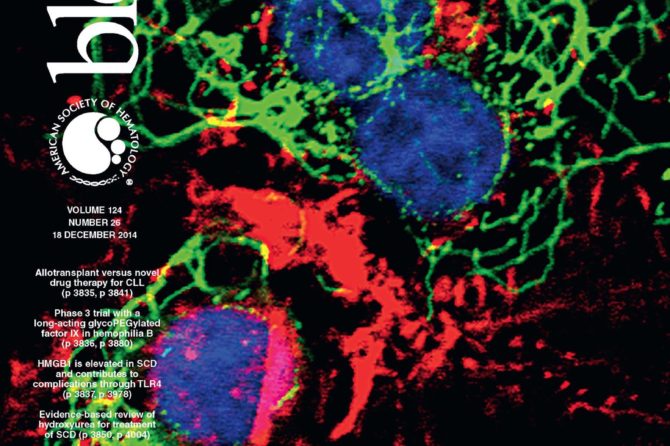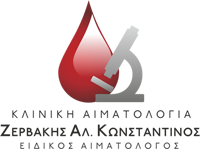
Μείωση των αναγκών μετάγγισης σε ασθενείς με μυελοδυσπλαστικό σύνδρομο
Abstract
Introduction
The hypomethylating agent 5-azacytidine (AZA) has been the standard of care for higher risk Myelodysplastic Syndromes (MDS) for the last few years. Its efficacy has been proven in large clinical trials, and its safety has been shown to be superior to that of conventional treatments. We have conducted a retrospective study about the efficacy and safety of 5-azacytidine, as reported and analyzed in our center.
Patients and Methods
Forty four consecutive patients with MDS or Acute Myeloid Leukemia (AML) with 20-30% bone marrow blasts that were treated with AZA during the last 63 months were included in the study. The clinical and laboratory characteristics of the patients were recorded, and the efficacy and safety data were analyzed.
Results
The epidemiologic and hematologic characteristics of the patients are shown in Table 1. The median overall survival was 13 months (1-101) and there was no primary treatment failure (Table 2). Serious adverse events consisted mostly of neutropenic infections (blood stream and pneumonia) (Table 3).
Discussion
Treatment with AZA offered a favorable (complete and partial) response in 34.1% of the patients, and an overall survival of 13 months, with generally predictable toxicities, although hospitalization was frequently inevitable during the first treatment cycles, when supportive treatment was a significant part of the management. A valuable observation is that there was a considerable decrease in the patients’ transfusion needs following treatment (p<0.0001). Our results are consistent with the results of other clinical trials and point out the need for investigational 5-azacytidine combinations.
| Male: Female ratio | 30:14 (2.1 : 1) |
|---|---|
| Age, Median (Range) | 73 (54-81) |
| WHO classification of MDS/AML, N (%) RAEB-I RAEB-II RCMD-RS RCMD RARS CMML AML |
9 (20.5) 18 (40.9) 2 (4.5) 3 (6.7) 1 (2.3) 4 (9.1) 7 (15.9) |
| IPSS classification, N (%) Low Intermediate-1 Intermediate-2 High Not Applicable (AML) |
0 (0) 3 (6.8) 29 (65.9) 5 (11.4) 7 (15.9) |
| Complete Blood Count Parameters, Median (Range) Hemoglobin (g/dL) Absolute Neutrophil Count (x109/L) Platelet count (x109/L) |
8.55 (4.5 – 12.5) 1.08 (0.0 – 16.3) 80.0 (2 – 820) |
| Transfusion dependence, N (%) | 39 (88.6) |
| Transfusions per month, Median (Range) | 3 (0 – 7) |
Table 1.
Epidemiologic and hematologic characteristics.
| AZA cycles, Median (Range) | 5 (1-22) |
|---|---|
| Actual AZA dose (mg/m2/cycle), Median (Range) | 75 (59-75) |
| Actual cycle duration (days), Median (Range) | 28 (28-40) |
| Dose reductions due to sustained neutropenia, N (%) | 6 (13.6) |
| Temporary AZA interruption, N (%) | 26 (59.1) |
| Reason | |
| Sustained cytopenia | 10/26 (38.5) |
| Neutropenic Infection | 15/26 (57.7) |
| Hemorrhagic Complication | 1/26 (3.8) |
| Permanent AZA discontinuation, N (%) | 23/44 (52.3) |
| Reason | |
| AML transformation | 17/23 (73.9) |
| Recurrent or severe infection | 4/23 (17.4) |
| Pyoderma gangrenosum | 1/23 (4.3) |
| Allogeneic Bone Marrow Transplantation | 1/23 (4.3) |
| AZA cycles till response (according to the IWG criteria), Median (Range) | 4 (1 – 7) |
| Response (IWG criteria), N (%) Complete response Partial response Stable disease Failure |
7 (15.9) 8 (18.2) 29 (65.9) 0 (0) |
| Overall survival (months), Median (Range) | 13 (1 – 101) |
| Post treatment transfusion dependence, N (%) | 34 (77.3) |
| Transfusions per month (post-treatment), Median (Range) | 1 (0 – 5) |
| Death rate, N (%) | 29/44 (65.9) |
| Cause of death, N (%) Infection Hemorrhage Cardiac dysrhythmia |
24/29 (82.8) 3/29 (10.3) 2/29 (6.9) |
Table 2.
Efficacy data
| Clinical adverse events, N (%) | 29/44 (65.9) | |
|---|---|---|
| Neutropenic Infections | 26/29 (89.7) | |
| Bloodstream Infection | 9/26 (34.6) | |
| Lower respiratory infection | 10/26 (38.5) | |
| Neutropenic Fever | 8/26 (30.1) | |
| Septic shock | 2/26 (7.7) | |
| Hemorrhagic events | 2/29 (6.7) | |
| Cerebral hemorrhage (Grade 5) | 1/2 (50.0) | |
| Epistaxis (Grade 3) | 1/2 (50.0) | |
| Other (pyoderma gangrenosum) | 1/29 (3.4) | |
| Laboratory incidents1, N (%) | 44/44 (100) | |
| All grades | Grades 3/4 | |
| Neutropenia | 36/44 (81.8) | 34/44 (77.3) |
| Anemia | 44/44 (100) | 24/44 (54.5) |
| Thrombocytopenia | 31/44 (70.5) | 21/44 (47.7) |
| Supportive treatment (during AZA administration), N (%) | ||
| GCSF administration | 16/44 (36.4) | |
| Erythropoietin administration | 7/44 (15.9) | |
| Red blood cell transfusions | 39/44 (88.6) | |
| Red blood cell transfusions (units/cycle), Median (range) | 3 (0-7) | |
| Pooled random donor platelet transfusions | 17 (38.6) | |
Article Information
- Published online December 4, 2014.
- Panagiotis Theodorou Diamantopoulos, 1National and Kapodistrian University of Athens, Laikon General Hospital, Athens, Greece
- Konstantinos Zervakis [MD], 2National Kapodistrian University of Athens, Laikon General Hospital, Athens, Greece
- Athanasios G. Galanopoulos, 3G. Gennimatas Hospital, Athens, Greece
- Panagiotis Bakarakos, 4“G. Gennimatas” District General Hospital, Athens, Greece
- Vasiliki Papadopoulou, 1National and Kapodistrian University of Athens, Laikon General Hospital, Athens, Greece
- Theodoros Iliakis, 1National and Kapodistrian University of Athens, Laikon General Hospital, Athens, Greece
- Fani Kalala, 1National and Kapodistrian University of Athens, Laikon General Hospital, Athens, Greece
- Nefeli Giannakopoulou, 1National and Kapodistrian University of Athens, Laikon General Hospital, Athens, Greece
- Niki Rougala, 1National and Kapodistrian University of Athens, Laikon General Hospital, Athens, Greece
- Eleni Variami, 1National and Kapodistrian University of Athens, Laikon General Hospital, Athens, Greece
- Aglaia Dimitrakopoulou, 5Laikon General Hospital, Athens, Greece
- Nora-Athina Viniou, 1National and Kapodistrian University of Athens, Laikon General Hospital, Athens, Greece

